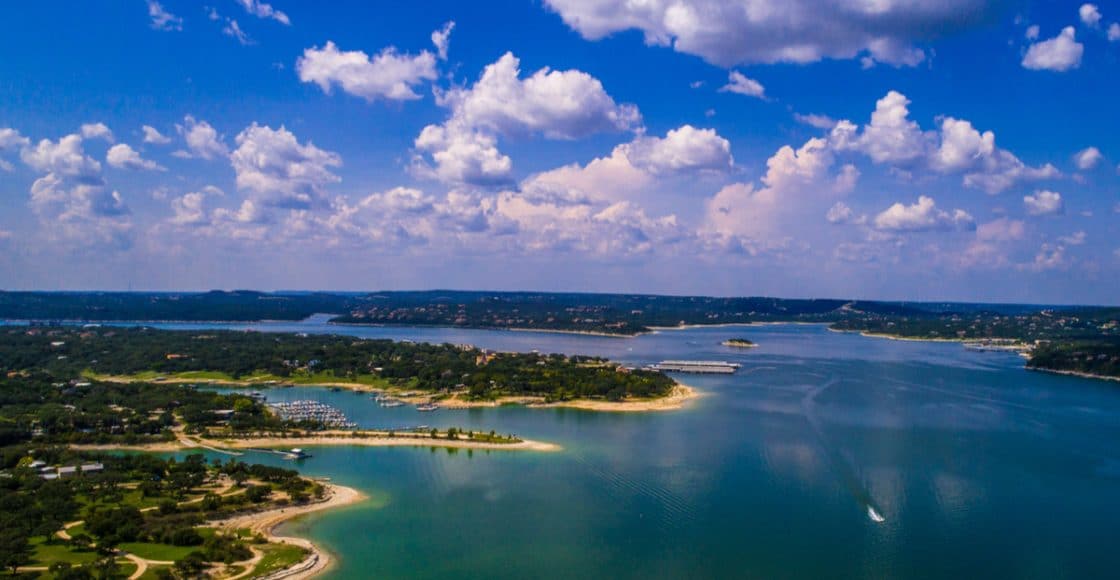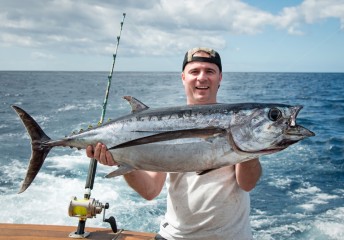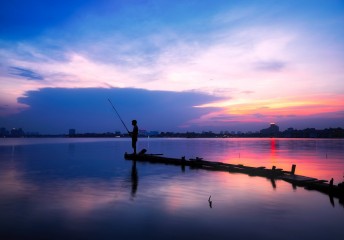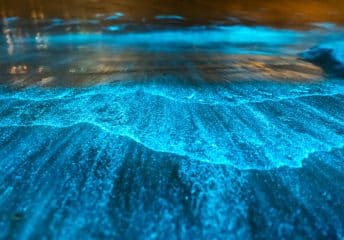8 Best Lakes Around Austin, TX
Last Updated on October 31, 2024 by Boatsetter Team
Austin, Texas is home to some of the best lakes in the country, with endless opportunities for on-the-water activities to explore with your friends and family. Here are 8 of our favorite lakes around Austin, Texas.
1. Lake Travis
Lake Travis sits 20 miles to the northwest of downtown Austin, Texas. It is an impressive nearly 19,000-acre reservoir lake that stretches almost 64 miles long and 4.5 miles wide. The lake’s average depth is 64 feet, but the deepest point sits near the Mansfield Dam at 190 feet. You should check out our guide to boating Lake Travis, Lake Travis water activities, or the famous Lake Travis Devil’s Cove
It’s no surprise that a lake of this size attracts many large and small boaters, swimmers, and anglers. In addition to these crowds, Travis is also a hotspot for divers and parasailers. The lake is deep and windy, making it the perfect site for adventurers. Lake Travis is also home to the only officially Texas-approved public nude beach.
2. Lake Austin
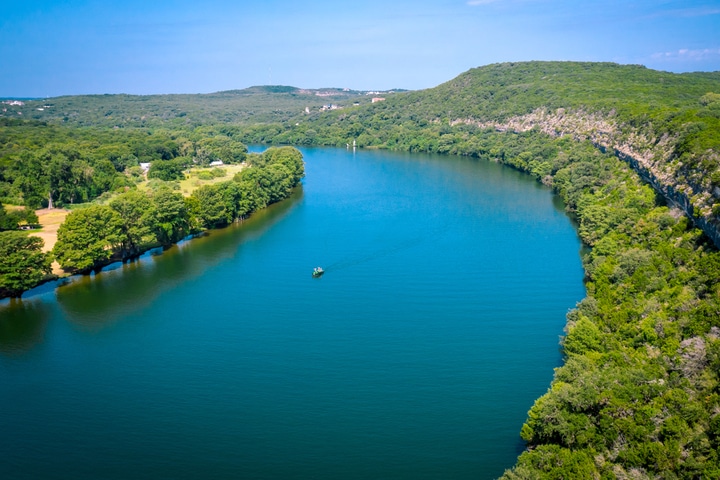
Lake Austin is a quick 12 miles northwest of downtown Austin. It sits perfectly in between Lake Travis and the city of Austin. Like Travis, it is situated on the Colorado River. Austin starts at Lake Travis’ Mansfield Dam to the north and ends at the hydroelectric Tom Miller Dam to the south.
This lake is long and narrow, with a nearly 1,600-acre surface area and a maximum depth of 75 feet. Because the lake is so narrow, all motorboats must stay to the right, except when necessary to assist water skiers.
Anglers love the lake for bass fishing; there are eight to ten-pound largemouth bass. Sunfish are another popular choice. You are most likely to find largemouth bass hiding in the weed beds on the shorelines of Lake Austin. Because of this, boat fishing is relatively difficult here. Early mornings and late evenings are your best time slots when the fish are most active. Central Texas is hot, with air temperatures in the high 90s (or higher) and surface water temperatures in the high 80s and 90s.
3. Lake Walter E. Long
Lake Walter E. Long is 10 miles to the east of downtown Austin and is almost completely encompassed by Decker Tallgrass Prairie Preserve, Louis Rene Barrera Indiangrass Wildlife Sanctuary, and the Walter E. Long Metropolitan Park. All of the shoreline is owned by the City of Austin.
The lake is 1,200 acres and features picnic sites, barbecue grills, picnic tables, restrooms, walking paths, biking, running, courtesy docks, and two well-maintained sand volleyball courts. The lake itself is frequently used for boating, skiing, and swimming. There are three concrete boat ramps available; You may fish from the banks, docks, or your boat.
While no overnight camping is permitted in the surrounding parks, the Austin East KOA is half a mile away from the boat ramp. It’s only a five to ten-minute walk from there to the ramp.
4. Mueller Lake
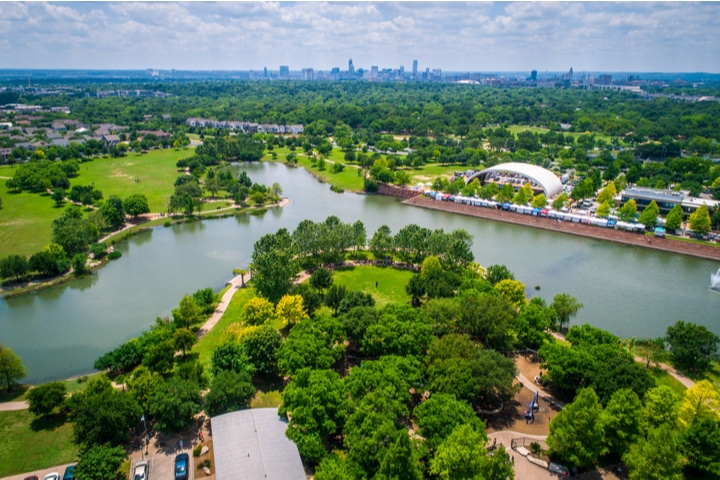
You can find Mueller Lake five miles northeast of downtown Austin, Texas, in Mueller Lake Park, adjacent to Patterson Park Community Garden and Patterson Neighborhood Pool.
The park is 30 acres, and the lake is 6.5 acres. While it is too small for boating, the lake is a scenic place to picnic, watch ducks, walk dogs, bike, fly kites, or simply enjoy the sunshine. An interactive playscape, picnic area, public art displays, and a large amphitheater and stage are part of the park, making it a key component of the Austin community.
5. Quarry Lake
Quarry Lake is ten miles north of downtown Austin and is now privately owned by the Pure Austin Fitness Center. It can be used at no additional cost to gym members or the general public with a day pass.
The lake is intended for swimming and offers a unique 750-meter course. You can also use a kayak or paddleboard, but it prohibits all other boats. Diving and fishing are also banned.
6. Lake Lyndon B Johnson
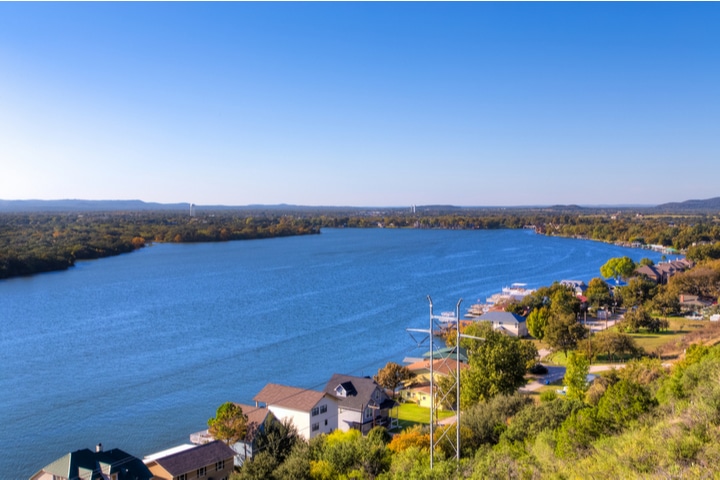
Lake Lyndon B Johnson is 53 miles northwest of downtown Austin and is on the Colorado River. It is a man-made reservoir used as a cooling water source for the Thomas C. Ferguson Power Plant. The lake got its name from President Lyndon B. Johnson, who owned a ranch on the shores.
Most of the lake’s land is privately owned, though a handful of small public parks are scattered on the lake’s shores.
Still, the lake is popular with boaters because the water level is consistent and full. This is thanks to the series of lakes and dams downstream that support and maintain the desired water level.
Most anglers come for the largemouth and white bass, catfish, sunfish, and crappie. The lake is regularly stocked to improve biodiversity and fishing conditions. Unfortunately, like most lakes on the Colorado River, the invasive hydrilla plant is widespread.
Officials are working to eradicate the plant but have been largely unsuccessful so far. Zebra mussels have also invaded the reservoirs that sit atop the Colorado River, so be sure always to wear shoes of some kind if you intend to walk the shoreline or contact the bottom of the lake. The mussel shells are sharp and uncomfortable to touch.
7. Canyon Lake
It is a 64-mile drive from downtown Austin to Canyon Lake, but well worth the trip. Often called “The Jewel” of Texas Hill Country, Canyon Lake is known for epic floats. It sits on the Guadalupe River, surrounded by massive overgrown cypress trees, which are gorgeous. The lake is 8,320 acres and has about 80 miles of shoreline to explore and enjoy.
Canyon Lake has excellent visibility; you can see about twenty feet down easily, and it is a hot spot for divers. In the 50s and 60s, the US Army Corps of Engineers gave Hill Country residents a warning that they would be displaced to create the dam and, thus, Canyon Lake. Still, most residents left behind many of their possessions. Houses (and the contents of many of the homes), outbuildings, vehicles, cemeteries, fences, and more are still under the lake. Divers love to explore underwater towns and look for hidden treasures.
Canyon Lake provides hiking trails, swim beaches, picnic sites, grills, dozens of boat ramps, courtesy docks, playgrounds, campgrounds, sandy volleyball courts, soccer fields, golf courses, resorts, country clubs, and yacht clubs, several marinas, and more.
8. Somerville Lake
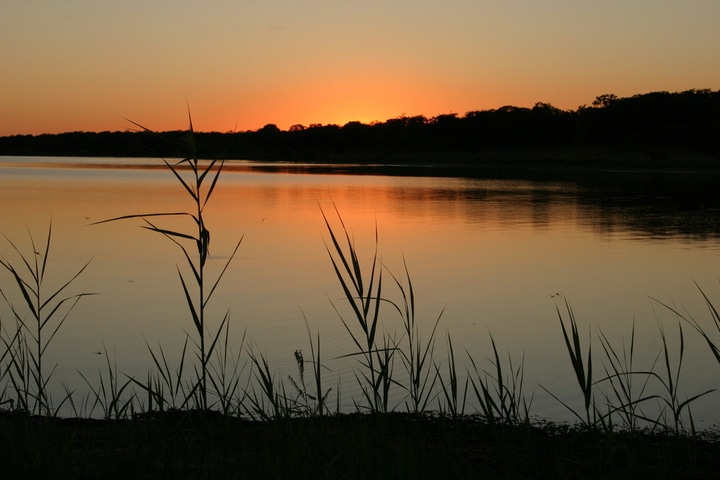
Located 90 miles to the east of Austin, Somerville Lake is the furthest lake on our list. Still, it is a beautiful 11,000-acre reservoir on Yegua Creek in the Brazos River Basin. The lake and surrounding area is filled with abundant wildlife, including alligators, bobcats, coyotes, whitetail deer, river otters, raccoons, rabbits, foxes, and many species of birds waterfowl, and quail.
Anglers come here for the white bass, white crappie, black crappie, largemouth bass, sunfish, and bluegill. You don’t need a fishing license to fish from the shore, but you will need one if you plan on fishing from a boat.
Hikers, horseback riders, geocache enthusiasts, and mountain bikers love the 40 miles of trails surrounding the lake; boaters come to enjoy the scenery, wildlife, and warm waters of the lake.
Are you ready for your next water-filled adventure on one of the lakes surrounding Austin? Now it’s time to find the right boat.
Explore some of the best beaches around Austin

Boatsetter empowers people to explore with confidence by showing them a world of possibility on the water. Rent a boat, list your boat, or become a Boatsetter captain today.
